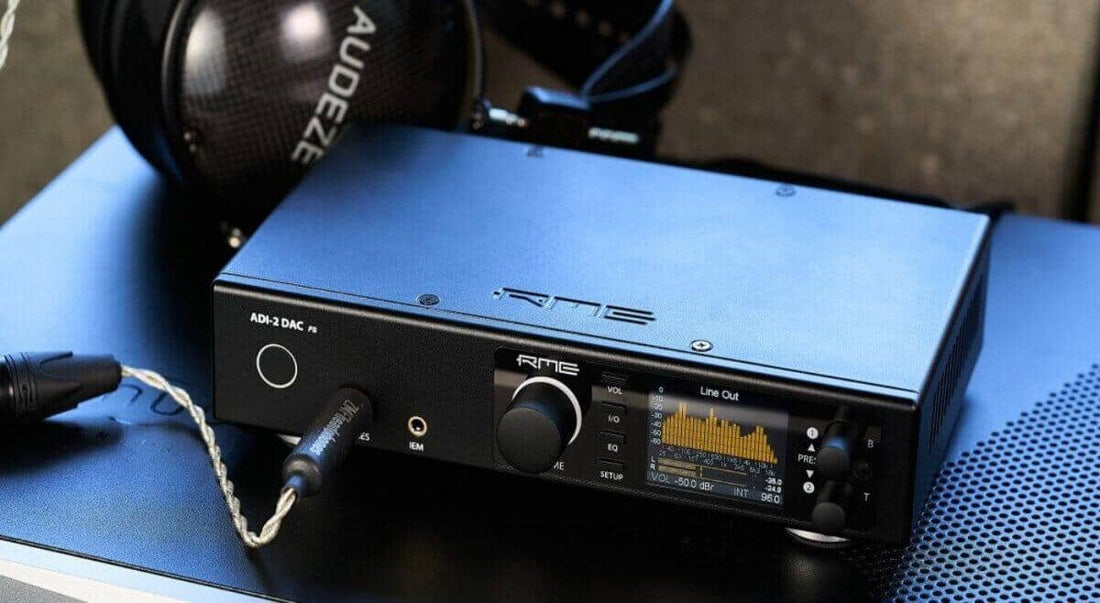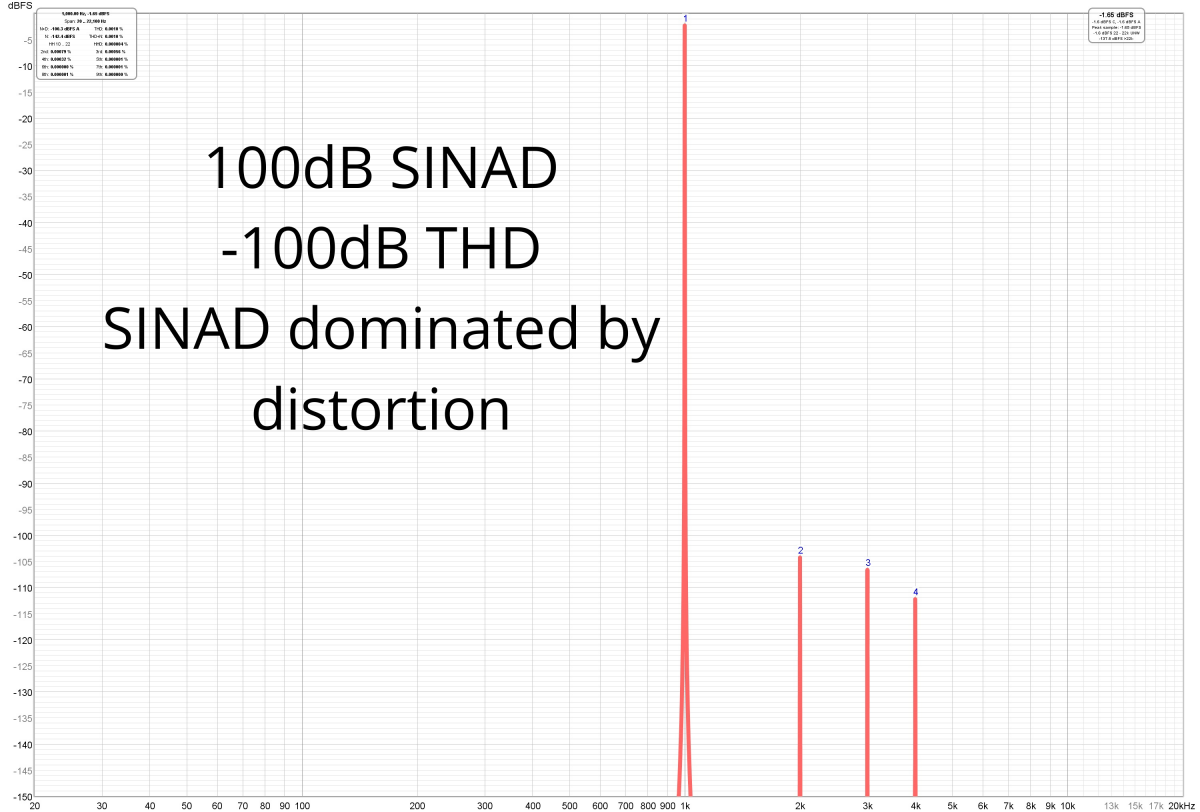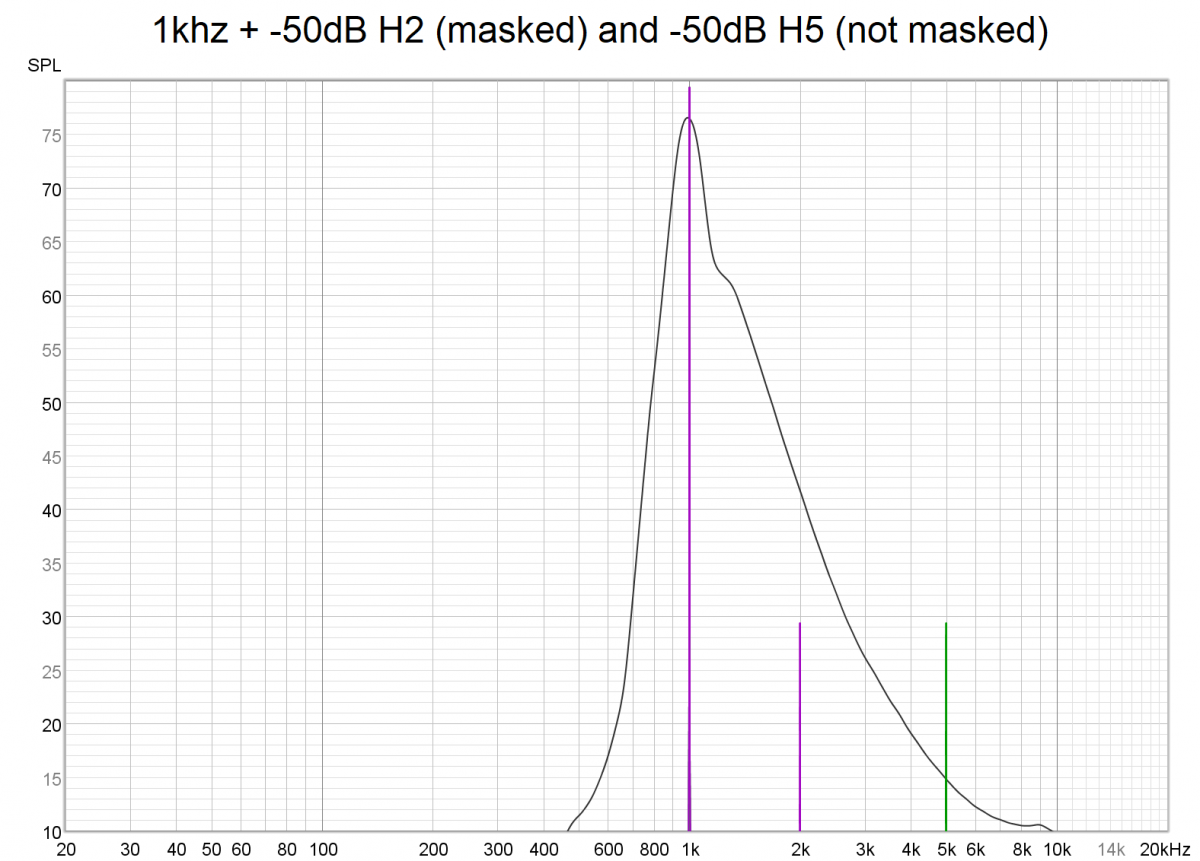Evaluating SINAD - Why it's NOT important

Written by Blaine LaCross and Andrew Park
Introduction - What is SINAD?
Editor's note - there is an additional companion piece to this article titled "Simulating Amplifier Distortion" where you can hear examples of real-world products.
SINAD, also known as THD+N, is very commonly quoted in a number of audio discussions. This term is generally brought up in relation to amplifier or other source equipment performance - but what is it? How relevant is it to what we hear? Let’s examine how SINAD works, and in this article we’ll explain why it’s not a useful measure or indicator of performance at all.
SINAD is short for “Signal to Noise And Distortion”. It’s the ratio between the signal - the stuff we want to hear, like the music we play - to all the other things we don’t want in the sound. It’s also sometimes expressed as THD+N, or “total harmonic distortion plus noise”, which is the ratio of the noise and distortion to the signal - the same thing the other way around.
As the name suggests, SINAD is a sum of two broad groups of things we don’t want in the sound: Noise, and distortion. Noise is just what it sounds like: noises leaking into your music, which can range from the “hum” of your AC power, to the “hiss” of white noise. There are a lot of potential sources of noise out there, and they can distract from what you actually want to listen to, particularly if you’re listening quietly.
Distortion, the other part, is similar to noise in that it’s an addition to your music. Unlike noise, however, distortion is produced by your music interacting with the flaws of the system. This means that distortion will be related in level to the signal causing it, whereas - as anyone who’s heard hiss on their IEMs will know - noise can be loud without anything playing at all.
Harmonic distortion is the distortion of a single frequency sine wave. It is frequencies that are multiples of the fundamental. For example, a fundamental tone of 1000hz, would have 2000hz, 3000hz, 4000hz, 5000hz, as its 2nd, 3rd, 4th and 5th harmonics. A distortionless amplifier or speaker fed a 1khz tone will only put out 1khz, but any nonlinear system will produce some amount of additional frequencies in the form of harmonic distortion, which will be related to the input in both level and frequency.
Since SINAD is a ratio to the sum of noise and distortion, it can be 'dominated' by one of the two if it is much higher. Because a 20dB difference is a tenfold change, the ratio doesn't change much between an amplifier with -80dB THD and -100dB noise, and one with -80dB THD and no noise at all. The following are examples of SINAD, one with distortion dominated equipment and the other with noise dominated equipment.
Distortion SINAD:

Here you see the fundamental tone (the strongest tone) at 1khz, with three harmonic distortion products (the lower three tones). Those three are 2nd, 3rd, and 4th harmonics.
Noise SINAD:

Here distortion is completely dominated by noise in SINAD - even though some harmonics are visible, they are not impacting the SINAD score at all due to the high noise
SINAD combines distortion and noise because it is a very old measurement - about a century old, in fact. In the early 1900s, it was difficult and expensive to separate out different types of signal problems, so SINAD and THD+N, which summed them all together and compared them to the desired output, became dominant. Measurements of SINAD could be done quickly and consistently even on very simple equipment, and their adoption paved the way for some very early innovations in audio technology.
However, because SINAD simply combines all of the unwanted parts of the signal into one number, it has trouble capturing what we hear. As early as 1950, there were suggestions to improve the calculation to better match subjective sound quality, but ultimately simplicity and inertia won out, and SINAD remains the same to this day.
Why is it bad to just sum things together though? Let’s start with a bit about how distortion and human hearing works to start explaining that.
Distortion
In order to demonstrate the downsides of using SINAD as an indicator for sound quality or equipment performance, let's take a closer look at distortion in general. Consider the following 1khz sine wave test tone:
Unlike music, which has a massive number of different frequencies, sines are “pure tones”. Because you know that a sine wave is supposed to have energy at just one frequency, you can easily tell that anything at any other frequency is either distortion or noise, and that’s how SINAD does it. As mentioned above, when a sine wave is distorted, it produces “harmonics” - multiples of its frequency.
For example, here's what a 1khz fundamental sounds like with its 2nd harmonic (2khz) being played at the same time at the same level:
That would be a SINAD of 20, and you can definitely hear it pretty clearly. Things get a bit more interesting when we lower the level of distortion, though. Here's what it sounds like with the 2nd harmonic at -50dB. Can you hear it?
Don’t feel bad if you can’t, it’s below the threshold that most studies find for the auditory masking effect. Basically due to the way your ear works, a loud sound at one frequency can “mask” a quieter one at a different frequency entirely, as though it was never there at all. The interesting thing about the masking effect is, though, that it applies less the further apart the two tones are.
Let’s see how audible the 5th harmonic, 5000hz, is at that same level:
You should be able to hear that annoying 5th harmonic creeping in, and this is because the masking from the 1khz tone isn’t as strong at 5000hz as 2000hz.
The auditory masking effect doesn't only apply to distortion, it also applies to all frequencies in music in general. But in this case, we can see that the 5th harmonic falls outside of the auditory masking window, while the 2nd harmonic falls inside of it.
The following image shows the range of frequencies that would fall within the auditory masking effect for a 1khz tone.

This is why you can hear that particularly annoying sound on the upper end of the recording that's intruding into your mix.
Now, this is an unrealistic test, because as said, a sine wave has only one frequency, but music has content at a massive range of frequencies all playing at once at different levels. And, in fact, studies have shown that humans tend to be more sensitive to distortion with pure tones than with music. A study by Steve Temme and Sean Olive even found that headphones with distortion exceeding 1%, or -40db, weren’t significantly less preferred when the frequency response was the same!
This is definitely for the best, given that speakers and headphones - particularly speakers - have pretty high distortion in general. For DACs, amplifiers, and other electronic devices, it’s a lot easier to get distortion low, however, and that makes it pretty easy to keep below a threshold where you ever need to worry about it. At -60dB, which is 0.1%, distortion products will typically only be heard in “edge cases”, like the sine wave above, and even then, only if they’re the right order of distortion. But, it’s very easy and cheap to get another order of magnitude of safety at -80dB or lower, where, if you listen at a safe volume, any distortion should be near the threshold of hearing even if you were listening onto to the distortion, in a perfectly quiet room. Given that an average cell phone dongle will have even lower distortion, you don’t need to worry too much about this specification.
Now, there's one additional piece to cover when it comes to distortion, and it has to do with the level a tone is being played at. On average, we'll be listening to music at somewhere around 80dB. But the peak volume of our average listening can be quite a bit higher than that. It's worth asking, should we be concerned about audible distortion products at the highest peak level being played, even if they don't show up at our average listening level at 80dB? The answer here is also no.
This is because the auditory masking effect also applies to volume level. It's much more difficult to hear distortion products when the signal is at a higher level than it is at a lower level - and this is true for test tones as well as for music. To demonstrate this, here are two tones at 315hz, both with the same level of 3rd harmonic distortion at -30dB from the fundamental. The only difference is that the second one is being played 20dB quieter.
315hz with -30dB 3rd harmonic distortion:
315hz with -30dB 3rd harmonic distortion, 20dB lower:
What's interesting about this test is that you can also demonstrate it by playing the same clip and changing your volume. Try playing the first tone at a lower volume and see if you can pick up the audible difference. This means that when it comes to peak level, we have even less reason to be worried about distortion products creeping into the music.
But this is just the distortion aspect of SINAD. The other is noise, which we'll discuss next.
Noise
Because the level of noise doesn’t necessarily depend on the level of the music, what constitutes a “safe” margin for noise is harder to pin down. Like distortion, noise is subject to the masking effect, but since some types of noise occur at all frequencies, music may not mask all of the noise even if it is loud enough to mask some of it. Even if your music does usually mask noise, you will have pauses, moments of silence, etc, so it’s clearly better if the noise isn’t audible even without any masking.
What does it take for noise to be inaudible? Well, the human threshold of hearing - the quietest sound we can hear - is around 0dBSPL in the most sensitive part of our hearing, so that should do it. Of course, you won’t actually hear something at the threshold of hearing if your room has a louder (or should I say ‘noisier’?) source of noise, because of the masking effect. Studies of residential room noise have found an average level above 15dBSPL in the midrange, but some rooms are quieter, so whether you want to “pad” your target by that amount is a matter of preference.
Room noise and hearing threshold, from Fielder 1995
So we want the noise of our electronics to be below either 0 or 15dBSPL - that sounds easy enough. A safe listening volume is about 80dBSPL, so that means we just need a SINAD of 80, right? Unfortunately, not quite - SINAD is specific to playback level, and you can’t extrapolate it as easily as you might hope for noise. For distortion, you can reasonably expect that if a headphone or amp is at .1% (60dB SINAD) at a high level, it’s going to be at .1% or less at a lower level, because distortion is caused by the signal. For noise, however, they can be completely unrelated, and that means that the relative level of the noise can rise with quieter listening.
It’s pretty typical to test the SINAD of an amplifier or DAC at a high level - usually over 1 volt, commonly 2. A SINAD of 80 at 2 volts caused by noise means that the noise is 1/10000th as much, or 0.2 millivolts. That doesn’t sound like much - and it isn’t - but it matters because headphones can be very sensitive. A HiFiMAN Susvara, which produces 95dBSPL for a 1 volt input, would only put out about 21dBSPL of noise from that 80 SINAD. However, a Campfire Andromeda IEM outputs 132dBSPL with a 1 volt input, so that noise would be a very audible 58dBSPL. So in some sense, scoring well on the noise aspect of SINAD means the equipment in question is particularly versatile - which can either matter a lot, or not at all depending on the headphones you're looking to use.
Because of this, it’s important to know both the level that a noise ratio was measured at, and the sensitivity of your headphones to determine if a level of noise will pose a problem. If the reference level would make your headphones ear-splittingly loud, you will need a much higher SNR (signal to noise ratio) or SINAD than if it would just get them to a listenable volume.
If you want to be really confident you’ll never hear any noise, and your headphones are on the more sensitive side of average, somewhere around 120dB of SNR/noise-dominated SINAD will probably cover the range from your Susvaras to your Audio Technica M50X or other more conventional headphones without noise ever rising to audibility. Conveniently, that’s also around the upper range of what’s possible with CD audio in terms of noise floor. To avoid hearing noise in your actual music, of course, you don’t need nearly as low of a noise floor.
That’s still a pretty strict specification compared to how much distortion you need to be comfortable with interfering with your sound, however, and unfortunately, with a SINAD score alone, you can’t differentiate between the two. An amplifier with a SINAD of 70 due to distortion might not audibly distort the sound at all, while another with 100 might audibly hiss or hum with sensitive headphones.
This is the big trouble with SINAD. In some cases, a low score points to an amplifier or DAC that is just plain not working, but in others, it’s only catching “problems” that you won’t actually be able to hear. At the outset of this project, we initially looked at trying to identify a “safe SINAD value” guideline where you didn’t need to worry about any audible problems above a certain threshold, but depending on what caused the SINAD, it could be anywhere from 50 to 140! This raises the question, is a measurement or index (like SINAD) perceptually relevant when that's the case?
Conclusion
This brings us to the conclusion, and a suggestion to readers who are looking to purchase a new piece of source equipment: Don’t bother with SINAD. If you want to understand the equipment's measured performance, look at the distortion and the noise separately to understand whether it will be appropriate for your situation or not. So long as the distortion is less than -80dB, and the noise is below 10dBSPL with headphones that have a similar sensitivity to the ones you're trying to run, you’re not going to hear a problem.
Once upon a time, SINAD made sense as a measure for audio electronics, but in the modern day we can get a lot more useful information with the same effort. That probably won’t stop manufacturers from publishing THD+N specifications, and there’s nothing wrong with that, but it’s not something we have a factually grounded reason to be worried about.
-Blaine Lacross, Andrew Park
Watch the video on this subject below:
---
References & Further reading on THD+N, distortion, and audibility:
D. Shorter, “The Influence of High Order Products on Nonlinear Distortion”, Electron. Eng. vol 22, pp.152-153, 1950
Vanderkooy & Krauel, “Another View of Distortion Perception”, JAES, 2012 https://www.aes.org/e-lib/browse.cfm?elib=16631
Louis Fielder, “Dynamic-Range Issues in the Modern Digital Audio Environment”, JAES,1995 https://www.aes.org/e-lib/online/browse.cfm?elib=7948
Louis Fielder, “Perceptual Assessment of Headphone Distortion”, JAES, 2017, https://www.aes.org/e-lib/browse.cfm?elib=19238
Mikhail Pahomov & Yong Hyuk Na Sr., “Method for Objective Evaluation of Nonlinear Distortion”, JAES, 2015, https://www.aes.org/e-lib/browse.cfm?elib=17995
Alex Voishvillo, “Measurements and Perception of Nonlinear Distortion - Comparing Numbers and Sound Quality”, JAES, 2007, https://www.aes.org/e-lib/browse.cfm?elib=17995
Alex Voishvillo, “Assessment of Nonlinearity in Transducers and Sound Systems - From THD to Perceptual Models”, JAES, 2006, https://www.aes.org/e-lib/browse.cfm?elib=13744
Voishvillo, Terekhov, Czerwinski, & Alexandrov, “Graphing, Interpretation, and Comparison of Results of Loudspeaker Nonlinear Distortion Measurements”, JAES, 2004, https://www.aes.org/e-lib/browse.cfm?elib=12996
Lidia Lee & Earl Geddes, “Auditory Perception of Nonlinear Distortion”, JAES, 2003, http://www.gedlee.com/Papers/Distortion_AES_II.pdf , https://www.aes.org/e-lib/browse.cfm?elib=12465
Phillip Minnick, “Nonlinear Distortion Measurement in Audio Amplifiers: The Perceptual Nonlinear Response”, JAES, 2012, https://www.aes.org/e-lib/browse.cfm?elib=16624
Temme, Brunet, & Qarabaqi, “Measurement of Harmonic Distortion Audibility Using a Simplified Psychoacoustic Model - Updated”, JAES, 2013, https://www.aes.org/e-lib/browse.cfm?elib=16885
Temme, Olive, Welti, & McMullin, “The Correlation between Distortion Audibility and Listener Preference in Headphones”, JAES, 2014, https://www.aes.org/e-lib/browse.cfm?elib=17441
